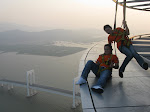On 26 June 2010, we had a family trip to Manila, Philippine.



















 Surrounding of Intramurous
Surrounding of IntramurousIntramuros, located along the southern bank of the Pasig River, was built by the Spaniards in the 16th century and is the oldest district of the city of Manila, the capital of the Philippines. Its name, in Latin, intramuros, literally "within the walls", meaning within the wall enclosure of the city/fortress, also describes its structure as it is surrounded by thick, high walls and moats. During the Spanish colonial period, Intramuros was considered Manila itself.


 Fort Santiago
Fort SantiagoFort Santiago (Spanish: Fuerte de Santiago Tagalog: Moog ng Santiago) is a defense fortress built for Spanish conquistador, Miguel Lopez de Legazpi. The fort is part of the structures of the walled city of Intramuros. Jose Rizal, the Philippines' national hero, was imprisoned in the fort before his execution in 1896. the site features, embedded onto the ground in bronze, his final footsteps representing the walk from his cell to the location of the actual execution.


 José Protasio Rizal Mercado y Alonso Realonda(June 19, 1861 – December 30, 1896, Bagumbayan), was a Filipino polymath, patriot and the most prominent advocate for reforms in the Philippines during the Spanish colonial era. He is considered a national hero of the Philippines and the anniversary of Rizal's death is commemorated as a Philippine holidayRizal Day. Rizal's 1896 military trial and execution made him a martyr of the Philippine Revolution.
José Protasio Rizal Mercado y Alonso Realonda(June 19, 1861 – December 30, 1896, Bagumbayan), was a Filipino polymath, patriot and the most prominent advocate for reforms in the Philippines during the Spanish colonial era. He is considered a national hero of the Philippines and the anniversary of Rizal's death is commemorated as a Philippine holidayRizal Day. Rizal's 1896 military trial and execution made him a martyr of the Philippine Revolution. Final foot step of Jose Rizal from Fort Santiago to Bagumbayan (now Luneta/Rizal park) before his execution.
Final foot step of Jose Rizal from Fort Santiago to Bagumbayan (now Luneta/Rizal park) before his execution.









 San Agustin Church is a Roman Catholic church under the auspices of The Order of St. Augustine, located inside the historic walled city of Intramuros. Completed by 1607, it is the oldest church still standing in the Philippines. No other surviving building in the Philippines has been claimed to pre-date San Agustin Church.
San Agustin Church is a Roman Catholic church under the auspices of The Order of St. Augustine, located inside the historic walled city of Intramuros. Completed by 1607, it is the oldest church still standing in the Philippines. No other surviving building in the Philippines has been claimed to pre-date San Agustin Church.



 Rizal monument has long been considered among the most famous sculptural landmarks in the country. It is almost protocol for visiting dignitaries to lay a wreath at the monument. Located at the Luneta is not merely the statue of the national hero, but also the mausoleum that houses his remains. Both statue and mausoleum are located near the very spot where Rizal was executed.
Rizal monument has long been considered among the most famous sculptural landmarks in the country. It is almost protocol for visiting dignitaries to lay a wreath at the monument. Located at the Luneta is not merely the statue of the national hero, but also the mausoleum that houses his remains. Both statue and mausoleum are located near the very spot where Rizal was executed.




















 Binondo is located across the Pasig River from Intramuros and the home of Chinatown in Manila. The district is the center of commerce and trade for all types of businesses run by Chinese merchants. It is said that this district was already a hub of Chinese commerce even before the Spaniards came in 1521.
Binondo is located across the Pasig River from Intramuros and the home of Chinatown in Manila. The district is the center of commerce and trade for all types of businesses run by Chinese merchants. It is said that this district was already a hub of Chinese commerce even before the Spaniards came in 1521.Binondo was sited by the Spaniards within the range of Intramuros cannons, to prevent any uprising coming from the Chinese.

 Prior to Makati, Binondo was the main center for business and finance in Manila for the Chinese, Chinese mestizos and Spanish Filipinos. Before World War II there was a bustling banking and financial community which included insurance companies, commercial banks and other financial institutions from Britain and the United States. The banks were located mostly in Escolta which used to be called the "Wall Street of the Philippines". After the war most of these businesses began to relocate to the newly developing area of Makati, which is mostly owned by the Ayala family.
Prior to Makati, Binondo was the main center for business and finance in Manila for the Chinese, Chinese mestizos and Spanish Filipinos. Before World War II there was a bustling banking and financial community which included insurance companies, commercial banks and other financial institutions from Britain and the United States. The banks were located mostly in Escolta which used to be called the "Wall Street of the Philippines". After the war most of these businesses began to relocate to the newly developing area of Makati, which is mostly owned by the Ayala family.


























































No comments:
Post a Comment